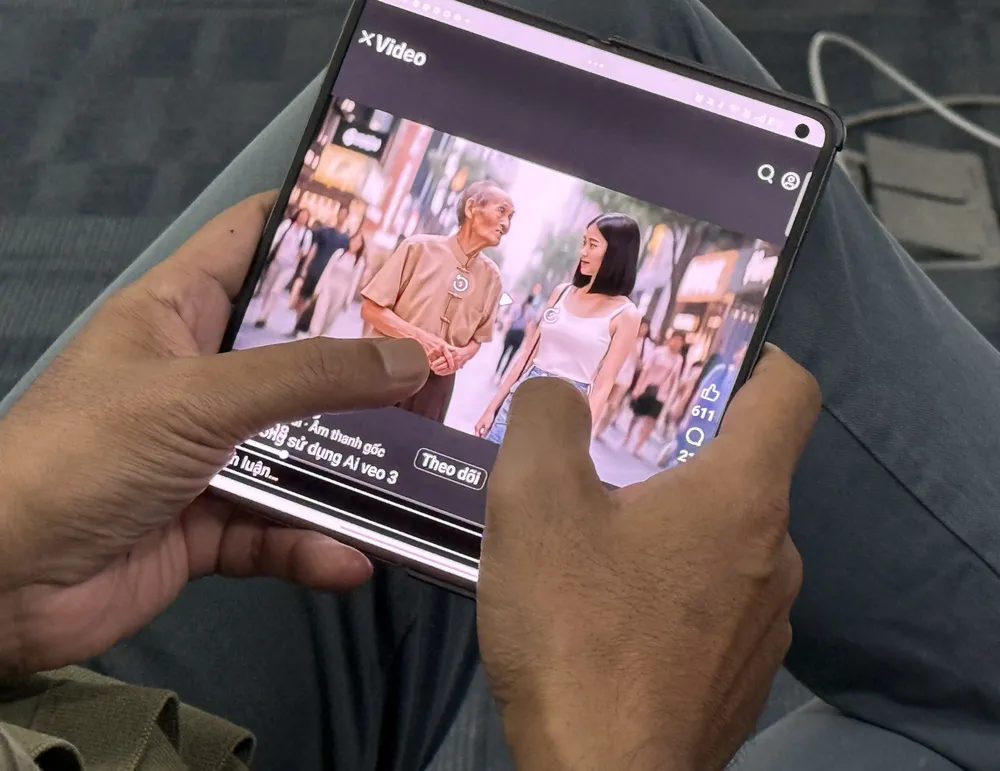Want what you want
Sitting in a coffee shop surfing the internet, Ms. Loan was startled to see on the screen an old man entering a “singing bar”, calling 5 long-legged girls at the same time and dancing freely… “That old man has a face similar to my old man. The image is beyond imagination, if the children in the house saw these images, what would they say… it would be a problem”, Ms. Loan shared.
Social media now has many AI videos with vulgar content from sound to images.
Another image, an old man carrying 3 young girls in cool clothes on a motorbike speeding down the street. The driver shouted: “You stay away from my back, two screws pressing into my back, how can I bear it…”. Or the image of a girl in a bikini walking in the middle of the market interviewing an old man with the content of badmouthing women; interviewing about her ex-lover with vulgar answers…
“Currently on social media platforms, there are hundreds and even thousands of videos created by AI tools, featuring scantily clad girls, obscene dialogues related to physiology, sex… and videos that break cultural values, approaching mobile users with smart algorithms. Whoever wants to make a video of any kind, that’s it,” Mr. Thanh Hoai, a bank employee, worried.
Nowadays, AI video creation tools are no longer strange such as HeyGen, Synthesia, Pictory, InVideo, Kling AI, Luma AI, Veed.io, FlexClip, Wave Video... Each tool has its own strengths in terms of features, image quality, avatar personalization, multi-language support, or integration of AI voiceover and special effects. AI videos with "realistic" quality and creating "excessive" images and sounds as mentioned above, appearing densely on the network environment, are mostly created from AI Google Veo 3. This is an AI model capable of creating videos from prompts, integrating vivid sounds such as dialogue between characters or animal sounds, which is considered to be significantly more advanced than other AI models, which only create "mute" videos or videos with simple background music.
AI videos, especially curious and vulgar videos, are quickly reaching the "ears and eyes" of mobile users because many people can register for service packages from AI tool providers from a few dozen USD to a few hundred USD per month. At the same time, many individuals also provide full-package AI video making services, such as basic packages: short videos, average images; advanced packages with high-quality videos, many effects; professional packages with creative videos, advanced features... with prices depending on length, complexity, additional features such as dubbing, multilingual subtitles, SEO optimization. "You can have any type of AI video you want, even if you want offensive, funny content, cool images in crowded places, "painful" dialogue... we can do it all," Trong Hoa, a content specialist (creating content for social networks), affirmed.
Many unpredictable consequences
Google says all content generated by Veo 3 is tagged with a SynthID watermark - DeepMind's technology that helps track and identify AI-generated content. The company also provides a safety guide, emphasizing the goal of helping users create and identify AI content responsibly...
But with the emergence of AI videos in general and from the Veo 3 tool in particular, the issue of AI ethics is raised from a specific perspective. AI distorts cultural identity: because AI can create “hybrid” versions of national culture, causing confusion about the origin, losing the soul of cultural identity, and in the long run making it difficult for the community to distinguish between the original value and the variation. Violation of cultural ownership rights: because AI easily collects, copies and replicates cultural elements without recognition or copyright protection, causing traditional values to be used widely. Social psychological impact: frequent exposure to fake content makes users confused, doubtful about the authenticity of all information, affecting social trust and common cultural values.
“The rapid development of this technology has made legal regulations, copyright protection measures and identification of real and fake not keep up, leading to many challenges in preserving and promoting traditional cultural values. It can be seen that Veo 3 is not only an entertainment tool, but also a breakthrough for the fields of communication, education , marketing, and even cinema. However, along with the opportunities are significant challenges, such as the risk of technology abuse, replacing humans in creative industries and the accompanying ethical issues. Therefore, the role of policies, ethical standards and digital skills education for the community is extremely important so that AI like Veo 3 can be developed and used responsibly,” said Mr. Phan Phuoc Quoc, Director of GenZ Company.
On the other hand, as AI tools develop, so does the risk of cyber attacks. The more sophisticated the AI tools that create videos, the risk of cyber attacks using deepfake will move to new, more dangerous forms. According to Kaspersky (one of the world's largest anti-virus software companies), on average, a deepfake attack occurs every 5 minutes, and it is predicted that by 2026, up to 90% of online content will be created using AI. The main target of deepfake attacks is still aimed at ordinary users with personal information, banking and payment...
“The risk of spreading false content and fake content using deepfake technology is worrying many people. AI tools like Veo 3 can be exploited to produce fake content, affecting the reputation of individuals and organizations or causing social information disorder,” said Mr. Vu Ngoc Son, Head of Research, Consulting, Technology Development and International Cooperation Department of the National Cyber Security Association (NCA).
BA TAN
Source: https://www.sggp.org.vn/canh-giac-video-ai-phan-cam-post799084.html





































































































Comment (0)